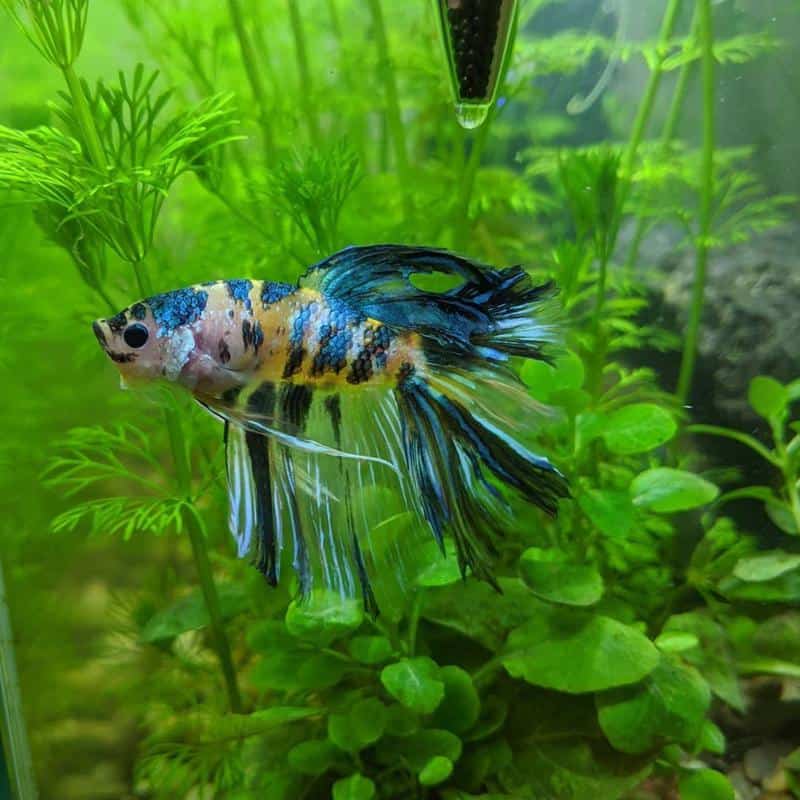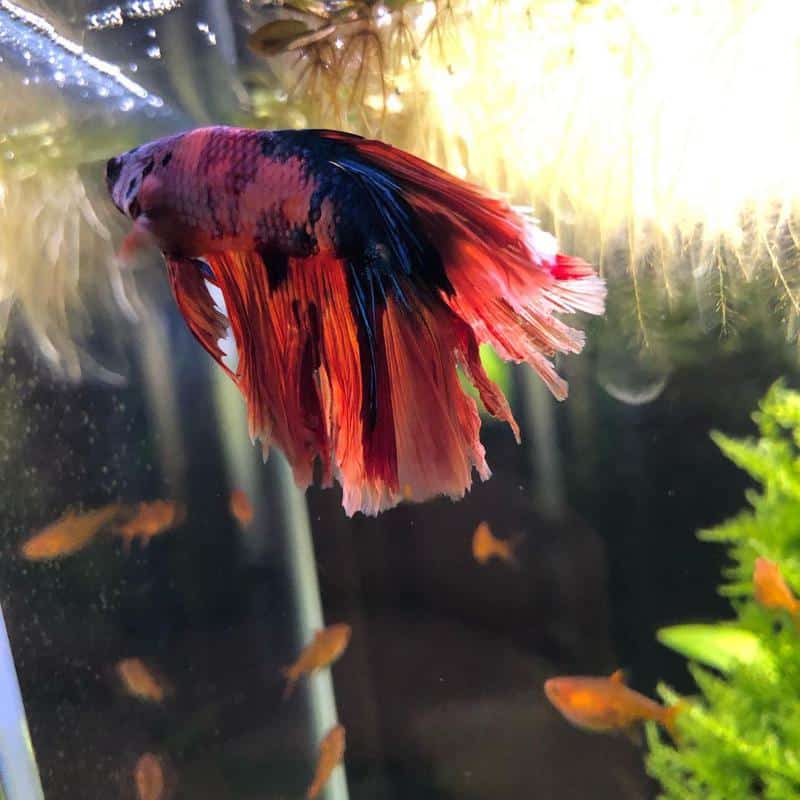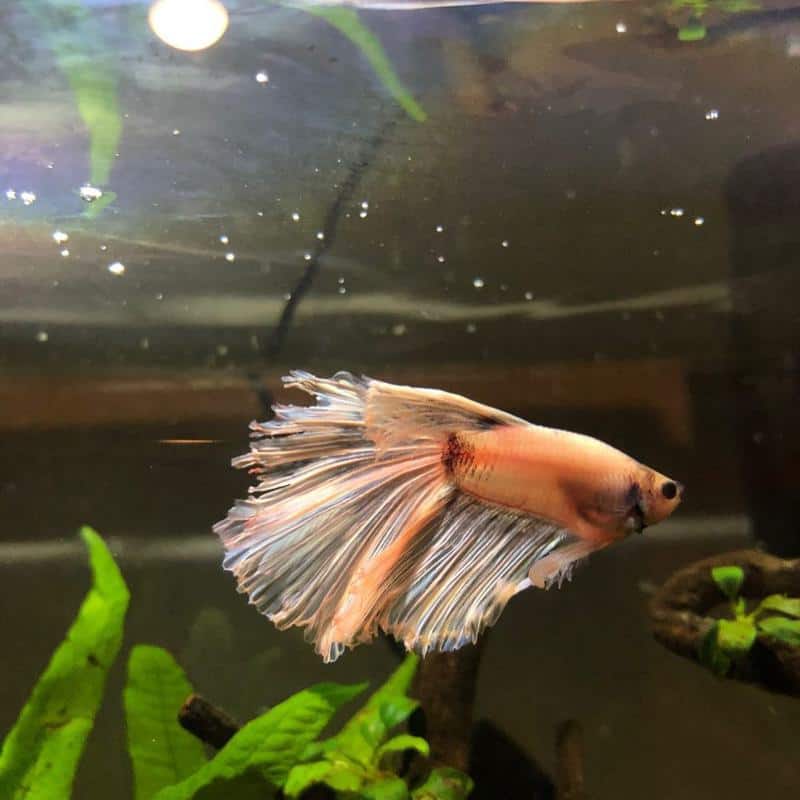Perhaps one day, you noticed the fins on your aquarium fish looking a little discolored or otherwise abnormal, but you’re not sure what the problem is and hence, aren’t sure how to fix it.
In this article, we’ll be looking at the issue of fin rot, and the ways you can identify it and subsequently treat the problem.
Fin rot is a disease in both salt and freshwater fish, where a weakened immune system allows bacteria to attack the fish and damage its fins, resulting in color changes, deterioration, and eventual loss of the fins. You can address the problem by treating the water, feeding high-quality fish food, and using antibiotics.
Before moving on to treatment options, let’s first take a look at what fin rot is exactly so that the later methods make sense.
What Is Fin Rot?

Fin rot is a commonly found bacterial disease in aquarium fish that, even though is easy to contract, is also easy enough to treat and prevent.
There are many types of bacteria that can cause fin rot in many types of fish, however, the infection all depends on whether your fish is in a healthy environment.
How Do Fish Develop Fin Rot?
Regardless of the type of fish infected, the cause of the infection is always due to some type of gram-negative bacteria. The most common types of bacteria that lead to fin rot are Aeromonas, pseudomonas, and vibrio bacterium.
Even though bacteria are common in fish tanks, fish aren’t usually susceptible to them because their immune system is constantly fighting them off (similar to our own). However, once their immune system is compromised, they then become easily vulnerable to infection.
There are various factors that can contribute to stress and a weakened immune system, including poor water quality, aggression, damaged fins, poor nutrition, and improper water temperature.
Poor Water Conditions
The most common cause of fin rot is poor water quality. This may be due to a plethora of factors, such as an imbalance of ammonia, nitrite, phosphate, or other chemicals, all resulting in the fish becoming stressed and its immune system being weakened.
If your fish happens to have become stressed due to poor water conditions, that can become a double whammy since a subpar environment can also allow bacteria to grow and thrive.
Worsening Physical Injuries
Another common cause of stress and a subsequent weakened immune system is some type of physical injury.
Because betta fins are quite fragile, they can be easily damaged by scrapes along rough or sharp surfaces, such as those on tank decoration or plants. They may also be damaged (both physically and mentally) by other fish that’re known to nip fins.
The Fish Are Having a Poor Diet
A more direct cause of a weakened immune system is a poor diet. If the betta is not having quality, high nutrition diets, they could suffer from malnutrition and a weakened immune system to the point where fin rot has a chance to infect them.
The Tank is Becoming Overcrowded
Nobody likes being in an overcrowded environment, and the same can be said about fish, in which an uncomfortable environment can lead to stress and eventually a weakened immune system.
A common rule of thumb is the idea that for every inch of fish in the water, there should be a corresponding gallon of water. Hence, the further you go beyond that limit, the more stressed your fish are likely to become.
Symptoms of Fin Rot
It’s important to understand the symptoms of fin rot so that you can tackle the issue early on while it’s relatively easy to treat (the symptoms will worsen as time goes on). Most of the symptoms you’ll come across include damaged fins or tails, discoloration, inflamed fins, and a loss of the fins/tails altogether.

Here is a general list of symptoms you may notice when fin rot affects your fish:
Discoloration of The Fins
The first symptom fish will usually develop when affected by fin rot is a discoloration of the fins, particularly at the edges. They will often appear a creamy/milky color, however, this change is small and can often go unnoticed by the casual fish owner.
Other areas on the body may also be affected, as black, white, or brown spots appearing on the fins, tail, or body are not uncommon.
Fins/Tail Begins to Fray
As the disease develops, you’ll likely begin noticing the fins and the tail becoming increasingly shorter as the tissues die and fall off the infected areas. This will initially leave the fins/tail with a ragged appearance, before eventually leading the entire thing to rot off altogether.
At this point, it should become obvious that there’s an issue affecting your fish as the infection has reached a life-threatening level of severity. If no action is taken by now, it won’t be long before your fish may perish.
Fins May Become Inflamed
As the fins and tail are rotting away, the skin at the base of the fins and tail might become red and inflamed if the issue is allowed to progress and no treatment has taken place.
Fish Are Likely to Become Lethargic
Once your fish has become seriously ill, it’ll likely stop eating and become slow and sluggish. You’ll be able to notice your fish becoming slower than usual and spending more time near the bottom of the tank.
This, combined with fin rot and any secondary bacterial infections that may occur (due to a weakened immune system and prior injury) during the initial infection, can quickly lead to death in the fish. You’ll be able to notice secondary bacterial infections when additional symptoms show up along with those for fin rot.
Is Fin Rot Contagious?
Yes, fin rot is often contagious to other fish because any close contact with the infected fish can easily transfer the bacterial infection to others. Because of this, the disease is sometimes nicknamed “aquarium fin rot”.
If you happen to have a group of fish sharing an aquarium tank and you’ve noticed one fish displaying symptoms of fin rot, you should move the infected fish to a separate quarantine tank until the infection has cleared up. This will reduce the chances of the bacterial infection spreading.
If all of the fish have become infected, it’s more likely that there is a widespread environmental issue rather than one fish infecting all the others. In this case, you can consider adding fish antibiotics straight to the tank (details of which we’ll go over later).
Fin Rot Treatment Options

Fin rot treatment options will vary depending on the disease’s severity and the type of fish affected (i.e. freshwater or saltwater).
You’ll typically need to address the cause of the stress first in order to prevent other fish from developing the infection or currently infected fish from being reinfected. You’ll typically do this by testing the aquarium water to assess your aquarium’s environmental health.
1. Check Water Parameters
You can do this by testing the aquarium water using a water testing kit. This will allow you to confirm whether the water parameters, such as the pH and temperature, are right for your fish.
It’s important to make sure the chlorine, ammonia, and nitrite levels aren’t above their recommended levels, and that the nitrate concentration is below 40 ppm (mg/L).
2. Perform a Partial Water Change and Remove Debris
Once you’ve adjusted the conditions of the water, the next step would be to perform a partial water change of roughly 25% of the water.
Even though poor water quality might be contributing to the fish’s stress, a complete water change is not recommended as that can remove all beneficial bacteria as well and induce even more stress on the fish. Performing a partial water change will reduce the likelihood of placing more stress on your fish while minimizing the impacts on the nitrogen cycle (and potential new tank syndrome).
A visual inspection of the tank filter and substrate may also prove helpful as these are good indicators of the amount of debris in the water. If you happen to find an overabundance of debris, you can clean out the filter (or in worse scenarios replace the filter) or vacuum the substrate in order to remove excess food and waste.
3. Using Aquarium Salt in Minor Cases
If fin rot hasn’t yet reached a critical stage, you may consider adding aquarium salt to your aquarium. The combination of aquarium salt and partial water changes can be an effective method of improving your fish’s health by reducing stress.
If you do decide to add freshwater salt or conduct salt baths/dips, you should consider using a refractometer to determine the concentration of the salt in the water to make sure you’re not adding too much.
Freshwater baths/dips can be very effective in reducing the bacteria on the fish while preventing antibiotic resistance (best used in less severe cases of fin rot).
4. Using Antibiotics in More Severe Cases
If the infection has reached a severe state, you’ll need to use antibiotics in order to kill the bacteria in the water and resolve any current infections that are going on. When deciding on which antibiotic to use, it’s best to consider those meant to target gram-negative organisms.
Some of the commonly used antibiotics used to eliminate aquarium fin rot include:
- Erthromycin
- MelaFix
- Tri-sulfa tablets
- Maracyn Oxy (in case of secondary fungal infections)
- PimaFix (in case of secondary fungal infections)
Most of the materials needed for the previous solutions we’ve discussed can be found over the counter, however, a prescription from your veterinarian will likely be needed for any antibiotics. This should be beneficial for you since a veterinarian will be able to determine the best antibiotic for you to use based on your specific situation.
When using antibiotics, be sure to always follow either your veterinarian’s guidelines or the instructions listed on the antibiotic’s packaging.
You’ll most likely need to add a specific amount of the antibiotic to the water based on the volume of your tank. Remember to remove or deactivate the filters during treatment, as they will probably absorb all the medication from the water.
Another thing to keep in mind is to continue the treatment for as long as necessary (duration should be listed on the antibiotic or listen to your veterinarian), as not completing the full cycle can potentially result in a recurrence of the infection.
Which Treatment Option Works Best?
Determining which treatment option works best will depend on your personal situation. As previously mentioned, the best method for you to use will depend on the severity of your fish’s infection.
If your fish only has a mild infection, then using aquarium salts may be your best bet as its relatively simpler than using antibiotics while being just as effective.
If your situation is more serious, your best choice would be to use antibiotics that, although somewhat harder to manage, are most effective at treating critical infections.
How Can You Prevent Reinfection?
Maintaining a Clean Environment
The best prevention measure is to maintain a clean aquarium environment. This involves things such as performing partial water changes on a regular basis, vacuuming the substrate, and regularly testing the water.
Giving the Fish Adequate Room
Bettas (and really any type of fish) should be kept in tanks that are large enough to provide them enough room to freely swim around and prevent overcrowding. Remember the 1 gallon of water per 1 inch of fish rule of thumb earlier to assist you in choosing the appropriate tank.
You should also remove some decorations if you notice the fish consistently bumping into them, as rough edges are another source of physical injury and eventual stress.
Don’t Overfeed or Underfeed Your Fish
You should also feed in small quantities twice a day (as opposed to one large meal), while ensuring the fish can consume all the food in roughly five minutes. Excess food in the tank is a common cause of poor water quality, which can produce all kinds of bacteria.
Remove Aggressive Fish from the Vulnerable Ones
Finally, be sure to keep aggressive fish away from each other, as fin-nipping (and other physical injuries to the fins) is another major factor to fin rot.
Also Read:
FAQs
1. How Can You Tell if The Fin Rot Is Improving?
Several signs can indicate your fish is improving, such as an improved diet, increased activity, regrowth of the fins, any changes in fin appearance, and the fact that there have been no further or worsening symptoms.
Since stress is a main factor in fin rot infections, a decrease in stress, which can be seen in more activity and an improved diet, will indicate that the fish is getting better.
And because the fins may take a while to regrow, you’ll likely see the skin around the fins improving first. Any clear or white tissue around the tail or fins is a sign of new skin growth (on the other hand, there is likely continued infection if you see red tissue).
2. How Long Does It Take to Heal?
Assuming all the treatment methods were applied appropriately, you should begin to see improvement in as little as two weeks. Even though the bacteria may be eliminated faster, the skin and fins/tail will often take quite a bit longer to regrow.
If you don’t see changes after two weeks, it may be time to consult your veterinarian to pursue more aggressive options.
Conclusion
Fin rot is one of the most common diseases aquarium owners come across, but luckily, it’s also one that can be easily prevented and treated.
As long as you follow the steps listed in this article, you can rest assured knowing your fish will be back to their old healthy, and energetic selves in no time.